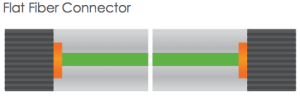PC vs UPC vs APC Fiber Optic Connectors Polishing Types
When choosing LC connectors, you might hear descriptions like LC UPC polished fiber optic connector, or LC APC connector. Or when choosing a ST fiber optic patch cable, you can find the description like ST/PC multimode fiber optic cable. What do PC, UPC, and APC stand for? The following text will give the explanations.

PC (physical contact), UPC (ultra physical contact) and APC (angle physical contact) are polish styles of ferrules inside the fiber optic connectors. Unlike copper cables with copper wire in the connectors as connection media, fiber optic connectors are with ceramic ferrules for connection. The picture on the left shows the ferrule in fiber optic connector. Different fiber optic connectors have different ferrule size and length. Also their polish style might be different.
To better understand why we have PC, UPC and APC, let’s start with the original fiber optic connector which has a flat-surface and is also known as flat connector (shown in the following picture). When two flat fiber connectors are mated, an air gap naturally forms between the two surfaces from small imperfections in the flat surfaces. The back reflection in flat connectors is about -14 dB or roughly 4%. To solve this problem, the PC connectors came into being.

In the PC connector, the two fibers meet, as they do with the flat connector, but the end faces are polished to be slightly curved or spherical. This eliminates the air gap and forces the fibers into contact. The back reflection is about -40 dB. The following picture shows two end faces of PC connectors.


UPC fiber connector which usually has a blue-colored body, is an improvement of the PC connector with a better surface finished (as showed in the following picture) by an extended polishing. The back reflection of UPC connector is about -55 dB which lower than that of a standard PC connector. UPC connectors are often used in digital, CATV and telephony systems.
PC and UPC connectors have reliable, low insertion losses. However, their back reflection depends on the surface finish of the fiber. The better the fiber gain structure, the lower the back reflection. If the PC and UPC connectors are continually mated and remated, back reflection will degrade. An APC fiber connector won’t have such problem. Its back reflection does not degrade with repeated matings.

APC connector usually has a green body with an end-face still curved but are angled at an industry-standard 8 degrees (showed in the above picture) which allows for even tight connections and smaller end-face radii. Thus any light that is redirected back towards the source is actually reflected out into the fiber cladding, again by virtue of the 8 degree angled end-face. APC ferrules offer return losses of -65dB. Some applications are more sensitive to return loss than others that call for APC connectors, like FTTx and Radio Frequency (RF) applications. APC connectors are also commonly used in passive optical applications due to the fact that many of these systems also use RF signals to deliver video.
PC, UPC or APC connector, which should be the choice of fiber optic connector? The answer is it depends. Choosing the appropriate connector for a fiber network depends on things such as, network design and function.

